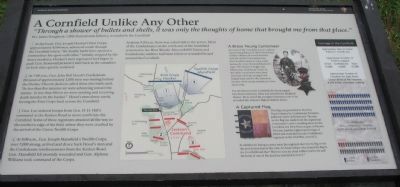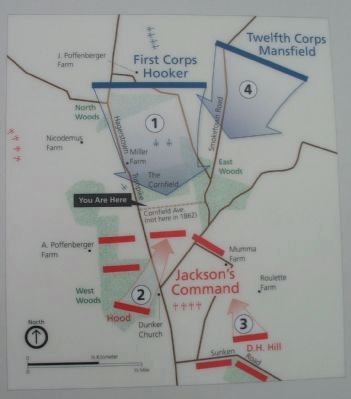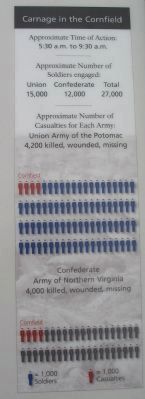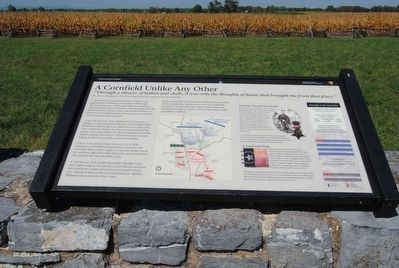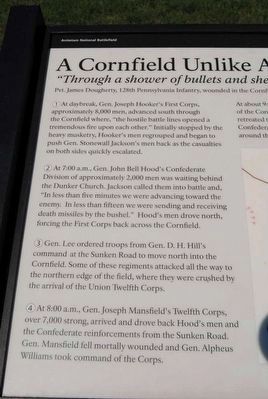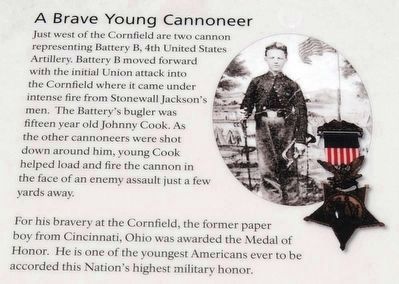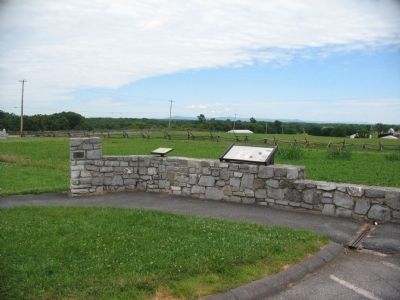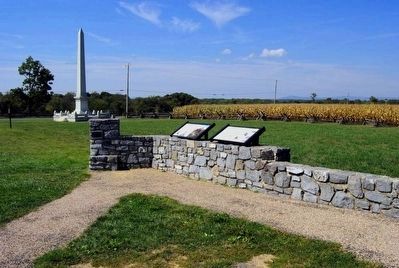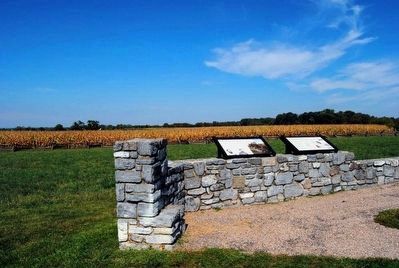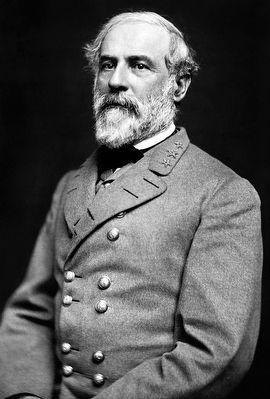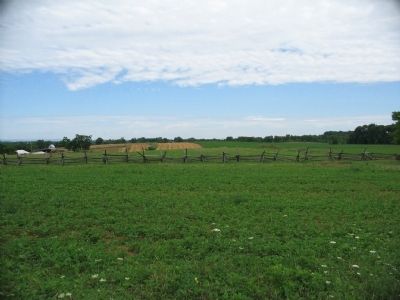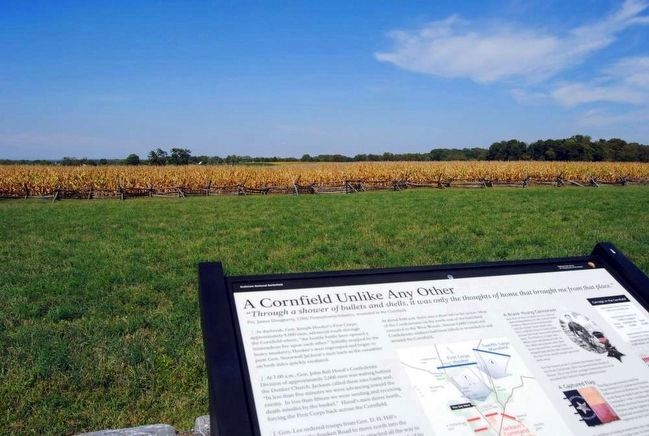Near Sharpsburg in Washington County, Maryland — The American Northeast (Mid-Atlantic)
A Cornfield Unlike Any Other
"Through a shower of bullets and shells, it was only the thoughts of home that brought me from that place."
Pvt. James Dougherty, 128th Pennsylvania Infantry, wounded in the Cornfield
(1) At daybreak, Gen. Joseph Hooker's First Corps, approximately 8,000 men, advanced south through the Cornfield where, "the hostile battle lines opened a tremendous fire upon each other." Initially stopped by the heavy musketry, Hooker's men regrouped and began to push Gen. Stonewall Jackson's men back as the casualties on both sides quickly escalated.
(2) At 7:00 a.m., Gen. John Bell Hood's Confederate Division of approximately 2,000 men was waiting behind the Dunker Church. Jackson called them into battle and, "In less than five minutes we were advancing toward the enemy. In less than fifteen we were sending and receiving death missiles by the bushel." Hood's men drove north, forcing the First Corps back across the Cornfield.
(3) Gen. Lee ordered troops from Gen. D.H. Hill's command at the Sunken Road to move north into the Cornfield. Some of these regiments attacked all the way to the northern edge of the field, where they were crushed by the arrival of the Union Twelfth Corps.
(4) At 8:00 a.m., Gen. Joseph Mansfield's Twelfth Corps, over 7,000 strong, arrived and drove back Hood's men and the Confederate reinforcements from the Sunken Road. Gen. Mansfield fell mortally wounded and Gen. Alpheus Williams took command of the Corps.
At about 9:00 a.m. there was a short lull in the action. Most of the Confederates on the north end of the battlefield retreated to the West Woods. Almost 8,000 Union and Confederate soldiers had been killed or wounded in and around the Cornfield.
A Brave Young Cannoneer
Just west of the Cornfield are two cannon representing Battery B, 4th United States Artillery. Battery B moved forward with the initial Union attack into the Cornfield where it came under intense fire from Stonewall Jackson's men. The Battery's bugler was fifteen year old Johnny Cook. As the other cannoneers were shot down around him, young Cook helped load and fire the cannon in the face of an enemy assault just a few yards away.
For his bravery at the Cornfield, the former paper boy from Cincinnati, Ohio was awarded the Medal of Honor. He is one of the youngest Americans ever to be awarded this Nation's highest military honor.
A Captured Flag
This flag was presented to the First Texas Infantry by Confederate President Jefferson Davis in Richmond. The star on the flag was made from the regimental commander's wife's wedding dress. In the Cornfield, the First Texas as part of Hood's Division, had the highest percentage of killed and wounded for any Confederate regiment in the Civil War, over 82%.
In addition to losing so many men, the regiment also lost its flag in the din and destruction in the corn. A Union soldier who found the flag in the Cornfield said that "thirteen men lay dead within touch of it and the body of one of the dead lay stretched across it."
Carnage in the Cornfield
Approximate Time of Action: 5:30 a.m. to 9 a.m.
Approximate Number of Soldiers engaged:
Union 15,000
Confederate 12,000
Total 27,000
Approximate Number of Casualties for Each Army:
Union Army of the Potomac
4,200 killed, wounded, missing
Confederate Army of Northern Virginia
4,000 killed, wounded, missing
Erected 2009 by Antietam National Battlefield - National Park Service - U.S. Department of the Interior.
Topics. This historical marker is listed in this topic list: War, US Civil. A significant historical date for this entry is September 17, 1862.
Location. 39° 28.856′ N, 77° 44.854′ W. Marker is near Sharpsburg, Maryland, in Washington County. Marker is on Cornfield Avenue near Dunker Church Road / Old Hagerstown Pike, on the right when traveling west. Located at stop four of the driving tour of the Antietam Battlefield. Touch for map. Marker is in this post office area: Sharpsburg MD 21782, United States of America. Touch for directions.
Other nearby markers. At least 10 other markers are within walking distance of this marker. "Every Stalk of Corn" (here, next to this marker); The Most Terrible Clash of Arms (here, next to this marker); Second Regiment (within shouting distance of this marker); Hood's Division, Longstreet's Command (within shouting distance of this marker); a different marker also named Hood's Division, Longstreet's Command (within shouting distance of this marker); First Army Corps (within shouting distance of this marker); Texas (within shouting distance of this marker); 84th New York (14th Brooklyn) Volunteer Infantry (within shouting distance of this marker); New Jersey State Monument (within shouting distance of this marker); Indiana State Monument (within shouting distance of this marker). Touch for a list and map of all markers in Sharpsburg.
More about this marker. In the center is a map depicting the unit movements, and keyed to the numbers related in the text. On the right is a portrait of Johnny Cook and a photo of the 1st Texas flag.
Related marker. Click here for another marker that is related to this marker. This marker replaced an older one titled "Every Stalk of Corn."
Also see . . .
1. Antietam Battlefield. National Park Service site. (Submitted on July 7, 2009, by Craig Swain of Leesburg, Virginia.)
2. Joseph Hooker. Joseph Hooker (November 13, 1814 – October 31, 1879) was a career United States Army officer, achieving the rank of major general in the Union Army during the American Civil War. (Submitted on October 20, 2015, by Brian Scott of Anderson, South Carolina.)
3. Stonewall Jackson. Thomas Jonathan "Stonewall" Jackson (January 21, 1824 – May 10, 1863) was a Confederate general during the American Civil War, and the best-known Confederate commander after General Robert E. Lee. (Submitted on October 20, 2015, by Brian Scott of Anderson, South Carolina.)
4. John Bell Hood. John Bell Hood (June 1 or June 29, 1831 – August 30, 1879) was a Confederate general during the American Civil War. (Submitted on October 20, 2015, by Brian Scott of Anderson, South Carolina.)
5. Robert E. Lee. Robert Edward Lee (January 19, 1807 – October 12, 1870) was an American soldier known for commanding the Confederate Army of Northern Virginia in the American Civil War from 1862 until his surrender in 1865. (Submitted on October 20, 2015, by Brian Scott of Anderson, South Carolina.)
6. Daniel Harvey Hill. Daniel Harvey Hill (July 12, 1821 – September 24, 1889) was a Confederate general during the American Civil War and a Southern scholar. (Submitted on October 20, 2015, by Brian Scott of Anderson, South Carolina.)
7. Joseph K. Mansfield. Joseph King Fenno Mansfield (December 22, 1803 – September 18, 1862) was a career United States Army officer, civil engineer, and a Union general in the American Civil War, mortally wounded at the Battle of Antietam. (Submitted on October 20, 2015, by Brian Scott of Anderson, South Carolina.)
8. Alpheus S. Williams. Alpheus Starkey Williams (September 29, 1810 – December 21, 1878) was a lawyer, judge, journalist, U.S. Congressman, and a Union general in the American Civil War. (Submitted on October 20, 2015, by Brian Scott of Anderson, South Carolina.)
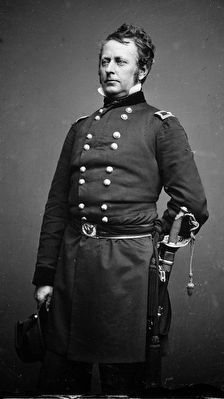
Photographed By Brian Scott, September 19, 2015
11. Major General Joseph Hooker (1814-1879)
At Antietam, his corps launched the first assault of the bloodiest day in American history, driving south into the corps of Lt. Gen. Stonewall Jackson, where they fought each other to a standstill. Hooker, aggressive and inspiring to his men, left the battle early in the morning with a foot wound. He asserted that the battle would have been a decisive Union victory if he had managed to stay on the field, but General McClellan's caution once again failed the Northern troops and Lee's much smaller army eluded destruction.
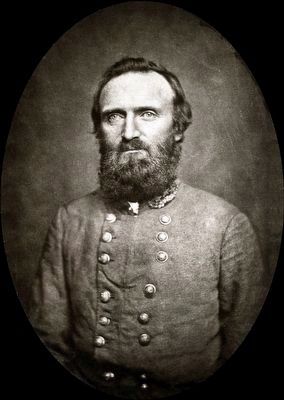
Photographed By Brian Scott
12. Lieut. General Thomas "Stonewall" Jackson (1824-1863)
Antietam was primarily a defensive battle against superior odds, although McClellan failed to exploit his advantage. Jackson's men bore the brunt of the initial attacks on the northern end of the battlefield and, at the end of the day, successfully resisted a breakthrough on the southern end when Jackson's subordinate, Maj. Gen. A.P. Hill, arrived at the last minute from Harpers Ferry.
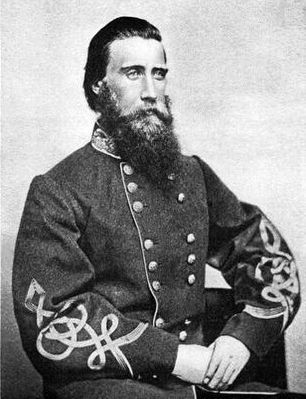
Photographed By Brian Scott
13. Lieut. General John B. Hood (1831-1879)
During the Battle of Antietam, Hood's division came to the relief of Stonewall Jackson's corps on the Confederate left flank, turning back an assault by the Union I Corps in the West Woods. Afterward, they became engaged with the Union XII Corps. In the evening after the battle, Gen. Lee asked Hood where his division was. He responded, "They are lying on the field where you sent them. My division has been almost wiped out." Of his 2,000 men, almost 1,000 were casualties
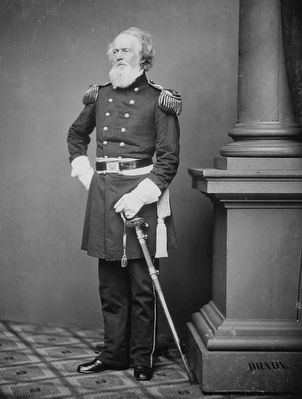
Library of Congress
15. Major General Joseph King Fenno Mansfield (1803-1862)
After being shot in the chest near the West Woods, he was taken to a field hospital at the George Line farm in Sharpsburg, where he died the next morning. He is buried in Indian Hill Cemetery, Middletown, Connecticut, and received a posthumous promotion to major general, backdated from July 18, 1862, for his gallantry at Antietam.
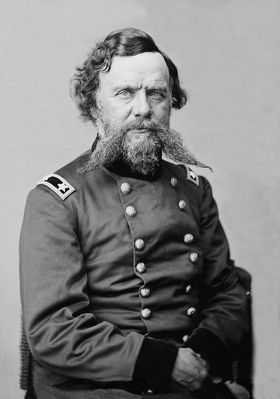
Photographed By Brian Scott
16. Brig. General Alpheus Starkey Williams (1810-1878)
The corps commander, Maj. Gen. Joseph K. Mansfield, was killed early at Antietam, and Williams assumed temporary command. The corps suffered heavy casualties in assaulting Jackson. Maj. Gen. Henry W. Slocum replaced Williams as permanent corps commander immediately after the battle.
Credits. This page was last revised on April 1, 2022. It was originally submitted on July 7, 2009, by Craig Swain of Leesburg, Virginia. This page has been viewed 1,679 times since then and 22 times this year. Photos: 1, 2, 3. submitted on July 7, 2009, by Craig Swain of Leesburg, Virginia. 4, 5, 6, 7. submitted on October 20, 2015, by Brian Scott of Anderson, South Carolina. 8. submitted on July 7, 2009, by Craig Swain of Leesburg, Virginia. 9, 10, 11, 12, 13, 14, 15, 16. submitted on October 20, 2015, by Brian Scott of Anderson, South Carolina. 17. submitted on July 7, 2009, by Craig Swain of Leesburg, Virginia. 18. submitted on October 20, 2015, by Brian Scott of Anderson, South Carolina.
